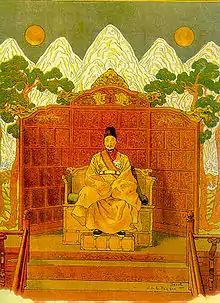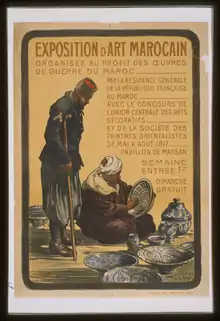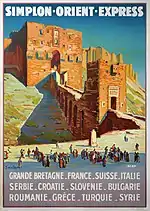Joseph de La Nézière
Joseph de La Nézière (1873–1944)[1] was a French painter noted for painting Orientalist scenes and for his work with the French Colonial Office and its program to reform the arts industries in colonial France.
Joseph de La Nézière | |
|---|---|
 Portrait of Joseph de La Nézière, 1910 | |
| Born | 5 August 1873 Bourges, France |
| Died | 15 April 1944 Casablanca, Morocco |
| Nationality | French |
| Education | Beaux-Arts Academy |
| Known for | Painter and illustrator |
| Movement | Orientalist |
Biography

Joseph de La Nézière was born in Bourges, France in 1873 and was born into a talented family. His brother, Raymond de La Nézière (1865-1953) became an illustrator.[2] His younger brother, Georges de la Nézière was killed in action in the first World War. As a child, Joseph was a very good student and learned piano, violin and Latin-Greek. He studied painting with artist, Alfred Roll, a member of the Beaux-Arts Academy.
La Nézière traveled extensively in North Africa and the Far East and became a well-known Orientalist artist. He was a member of the Geographic Society.
He held various administrative roles with the French Colonial office which had embarked on a sophisticated program to reform the arts industries in colonial France. La Nézière employed many Orientalist painters to assist him and also employed both men and women in equal numbers.[3] In around 1919, he headed a project based in Rabat, Morocco to produce some 300 Oriental rugs under the auspices of the Office des Industries d'Artes Indigenes. Destined for sale on the French market, these rugs were sold immediately and were enormously popular. They became known as the "Middle Atlas" rug.[4]
He was a member French Society of Orientalist Painters and regularly exhibited at their Paris exhibitions.[5]
As the official painter for the French Colonial Office,[6] he was commissioned in 1910 to illustrate the stamps for the postal service of French North African colonies. He also created a series of famous posters for the Paris Colonial Exposition of 1931.
In 1943, he returned to France with his student, Henri Marie-Rose, but before long he once again travelled to Morocco where he died on April 15, 1944, in Casablanca, Morocco.[7]
Work
He has worked as a portrait painter, landscape painter, poster artist, travel journalist in far-off countries, painted dioramas and made postage stamps in France, the Middle East and Africa. He illustrated the book, Siamese Life Scenes, by Louis P. Rivière. He also authored a number of books which were richly illustrated with his artwork. His principal medium was watercolour.
Selected artwork
 Vue de Gennevilliers, 1910
Vue de Gennevilliers, 1910 Korea, Far East (lithograph), 1903
Korea, Far East (lithograph), 1903 Gojong, King of the Korean Empire, 1903
Gojong, King of the Korean Empire, 1903 Exposition of Moroccan Art, (poster), 1917
Exposition of Moroccan Art, (poster), 1917 Simplon-Orient-Express poster
Simplon-Orient-Express poster Women, wearing white on their way to Rabat, Morocco, painting by La Nézière, 1916
Women, wearing white on their way to Rabat, Morocco, painting by La Nézière, 1916
Books
- L'Extrême-Orient en images: Sibérie, Chine, Corée, Japon Paris, 1904
- Les Monuments Mauresques du Maroc, Volume 1, A. Lévy, 1922
- La Décoration Marocaine A. Calavas, 1924
See also
Notes
- Akoun 2004
- L'Étang, G. and Arsaye, J-P., La Peinture en Martinique, HC, 2007, p.18
- Benjamin, R., Orientalist Aesthetics: Art, Colonialism, and French North Africa, 1880-1930, University of California Press, 2003, pp 203-04
- Pouillion, F. and Vatin, J-C. (eds), After Orientalism: Critical Perspectives on Western Agency and Eastern Re-appropriations, BRILL, 2014, p. 225; Benjamin, R., Orientalist Aesthetics: Art, Colonialism, and French North Africa, 1880-1930, University of California Press, 2003, pp 203-04
- Benjamin, R., Orientalist Aesthetics: Art, Colonialism, and French North Africa, 1880-1930, University of California Press, 2003, p. 204; Jay, M and Ramaswamy, S., Empires of Vision: A Reader, Duke University Press, 2014, p. 128
- L'Étang, G. and Arsaye, J-P., La Peinture en Martinique, HC, 2007, p.18
- L'Étang, G. and Arsaye, J-P., La Peinture en Martinique, HC, 2007, p.23
Sources
- Akoun 2004, la Cote de l'Amateur publishing, p. 470
- The Globe Trotter, 1912. "New Stamps for the French Colonies", p. 92
- the French Post Museum website, France